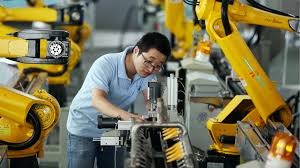Source: syncedreview.com
After running the industrial robot operating system startup “Cobot” for three years, founder Miao Li has decided to axe 98 percent of the company’s “fancy services” and just focus on drug logistics and sorting mushrooms.
Although the countless pages of operating system manuals he’d produced represented an investment of over US$15 million, Miao believes his company will be better served by perfecting “one platform (and OS) and two scenarios (smart detection and flexible grasping)”.
Miao’s entrepreneurial journey started off smoothly and successfully. He founded Cobot in May 2016 and by late 2017 the company had amassed over US$15 million in series B funding led by GGV Capital and Lan Fund. This spring Cobot visited the Hannover Messe industrial fair in Germany to showcase its flagship AI-implanted manipulation system “COBOTSYS.”
Even a young robotics software startup however will have research initiatives that just get “swept under the carpet”. In just the past year, Cobot explored then abandoned robotics solutions for electronics, auto parts, food, logistics, healthcare and R&D. Miao says 99 percent of the time gets wasted on “dirty work” and hardly-useful cases.
Developing a simple classification system for example for sorting shiitake mushrooms can be fraught with frustrations. There is no existing data for this task, typically it’s done manually by human labour. Miao says the first 100 gigabytes of mushroom image data collected by Cobat researchers had to be trashed due to insufficient lighting. The team then had to have human experts correct errors with their data labelling. Only after solving these and other issues was Cobat able to get their AI-powered system’s recognition accuracy up to 90-95 percent.
As an operating system startup, Cobot is in a less dominant position than hardware vendors or system integration companies when it comes down to negotiating deals. Third-party companies also tend to get paid last.
The Chinese industrial robotics market is tough for startups to crack. According to data from Xinhua News, 2018 saw cumulative sales of 156,000 robot units, 70 percent of which were imported. Moreover, scaled production usually refers to shipments of 10,000 units and above, a volume beyond the ability of most startups. Many are suffering from negative profits or relying heavily on government subsidies.
Before startups like Cobot emerged, the industrial robot market was firmly in the grip of four industry giants: Fanuc, ABB, Kuka and Yaskawa. There are also established competitors such as Japan’s Nachi-Fujikoshi, Kawasaki Heavy Industries, Europe’s DURR and SASMES, and Adept from the US.
In China the big four industrial robot companies have about 49.7 percent of the market, with particularly strong advantages in auto and electronics manufacturing. Startups such as Cobot can only survive by offering highly differentiated products and services, and Miao decided to carve out a niche in traditional industrial scenarios that were data-poor.
Miao’s team is now adding drug logistics to its automated industrial applications. At a hospital in Shekou, Shenzhen, Cobot’s flexible grappling robot is sorting medicines at a rate of 800 boxes/hour, with recognition accuracy of 99.8 percent. The system also uses data such as batch numbers to ensure drug shipments based are delivered within expiration dates.
“The industry is trying hard to make sales pitches for robotics operating systems,” says Miao, “and this means convincing them with real statistics. For instance, our recognition accuracy for shiitake mushrooms is now 99 percent. A factory that installs five mushroom lines can replace 80 workers, saving up to US$400,000 and breaking even on automation cost within a year.”
The road ahead will not be easy for startups like Cobot. Global industrial robot revenue growth was just 0.9 percent in 2019, and net profits fell by 39 percent. Already impacted by slow growth economies and sluggish automobile and electronics sales, the robotics industry is anticipating further setbacks. To make matters worse, even as robot industry revenue streams dry up, the sector’s average R&D costs rose this year by 12.4 percent.
Cobot systems are currently in use in more than a dozen hospitals in China, mainly major, financially-healthy hospitals in Shenzhen, Guangzhou, and Zhongshan. Although the past few years have seen anxiety and hardship ripple through the industry, Miao remains confident he’s on the right track: “There is a definite future for robotics operating systems.”


